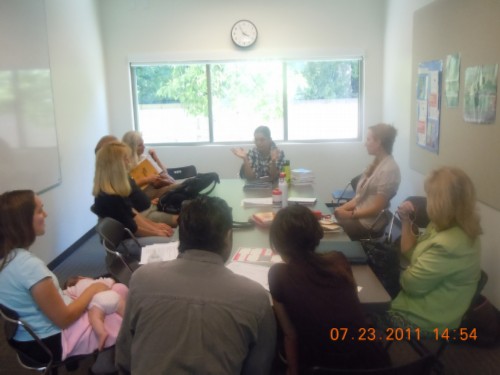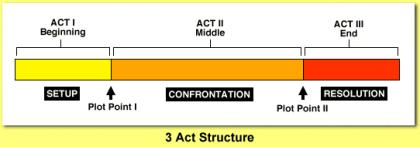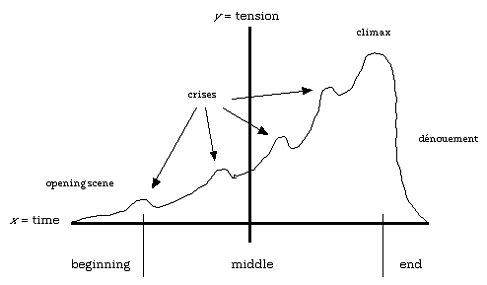Our writing group always met at Borders in Torrance. But last week, they announced that they would be closing all 399 stores, so we lost our only sponsor. I had scheduled our meetups with them all the way up to September, and now I had to scramble to find us new venues.
Saturday, July 23rd, 2011 was supposed to be our last ever meeting in Borders. But when I passed by on Friday to check, I was greeted by a long line to the cashier that snaked around the store. There were tons of people bargain hunting and the shelves were nearly in disarray.
In short, I had to quickly find a new venue for our group. I emailed those who had RSVP’d for the event and informed them of the situation. I asked for their cellphone numbers so I could text them the new venue address the following day.
Early on Saturday, I drove to the nearest library. I waited for the doors to open, and as soon as it did, I rushed to the Reference Desk clerk.
I told her our situation and she suggested one of the conference rooms. They were supposed to be used on a first come, first served basis, but she reserved it for our group’s use from 1-4pm. The clerk used to be a member of the SCBWI, and was more than happy to help our group.
I was so happy to have found us a great venue at such short notice. I quickly emailed and texted all my members, and though a few of them didn’t make it, most of them were happy they did come---because I gave out a whole bunch of handouts and worksheets on plotting.

Torrance Children's Book Writers, photo by Janet Merrigan
Most of the worksheets and handouts were based on Deborah Halverson’s incredibly helpful book Writing Young Adult Fiction for Dummies, and Evan Marshall’s equally useful Marshall Plan for Novel Writing.
Following is an abbreviated transcript of the session:
ALL ABOUT PLOTTING
Some people are plotters-they like to outline the story and develop their characters before they even begin writing the first draft. Some are pantsers- they start with a story idea and just go from there.
Everyone has a different approach to writing, particularly to plotting. While outlining works for some people, it might not be a pleasant experience for others.
Whether you're plotters or pantsers doesn’t matter. What matters is that you learn as much as you can about plotting from several different sources. Because in the end, only you can decide what works for you or not.
The first thing you need to do when reading any writing bookundefinedespecially one on plotting, is to understand what is being said. Once you understand the rule, then you can take it and use it as is, or adapt it in the way that makes sense for you.
You must think of every writing book you read, and every writing session you attend as a GUIDE and not as a set of fixed rules or commandments.
You can follow whatever you learn from today’s session about plotting to the letter, you can tweak the steps to suit your style, or you can even add and subtract certain steps. The point is that as long as you understand the “rules”, feel free to break them.
BEFORE YOU PLOT YOUR NOVEL
Before we actually start plotting our novels, there are certain very important things we must first do.
A. TARGET AGE RANGE & GENDER
Who are you writing for?
Are you writing for children or adults?
- Knowing the exact age range of your audience will help keep your plot on track.
- Not only that, it will help you when you begin to query your work, and will help publishers and booksellers know where to place your books on the shelf.
- Let’s go over the following handout really quickly.
Handout 1: Understanding Children’s Book Genres by Laura Backes
Are you writing for girls or boys?
From Deborah Halverson’s Writing Young Adult Fiction for Dummies:
B. TARGET AGE RANGE
Now that you know the age range of your target audience, it’ll be easy to figure out the word count for each.
Why is word count important?
C. TARGET GENRE
Knowing the genre of the book you are writing/planning to write will help agents/publishers decide whether to pick you as a client or not.
But within each general genre, there are also specific types of sub-genresundefinedand knowing these will help you keep on track when plotting/ writing your stories.
Handout 2: Genres and How to Choose One pp.30-33 The Marshall Plan Workbook by Evan Marshall
D. TARGET YOUR THEME
From Deborah Halverson’s Writing Young Adult Fiction for Dummies:
Worksheet 1: Choose Your Theme. p. 33, Writing Young Adult Fiction for Dummies by Deborah Halverson
E. FIND YOUR STORY IDEA/ HOOK
Worksheet 2: Write Your Hook. p. 71-72, Writing Young Adult Fiction for Dummies by Deborah Halverson.
Worksheet 3: Novel Information at a Glance
F. FLESH OUT YOUR CHARACTERS
1. Worksheet 4: Character Thumbnail & Profile by Deborah Halverson
2. Worksheet 5: The Marshall Plan Character Fact Lists by Evan Marshall
3. Worksheet 6: Comprehensive Character Profile (compiled by myself)
No matter what worksheet/ character development technique you wish to use, there is one particular technique that you all must know and use. If there’s one technique that I recommend you use, it would be this one:
GMC or Goals, Motivation, Conflict by Debra Dixon
Handout 3: Goals, Motivations, Conflict by Debra Dixon
WHO, WHAT, WHY, AND WHY NOT
From Debra Dixon's Goals, Motivations, Conflict
· These are important questions for any story
|
Who
|
Character
|
|
What
|
Goal
|
|
Why
|
Motivation
|
|
Why Not
|
Conflict
|
- A character wants a goal because he is motivated, but he faces conflict
|
DOROTHY
|
EXTERNAL
|
INTERNAL
|
|
Goal
|
GET HOME
1. Get to the Emerald City
2. See the Wizard
3. Get the broomstick
|
To find her heart’s desire and a place with no trouble
|
|
Motivation
|
Auntie Em is Sick
1. The Wizard is there.
2. He has the power to send her home.
3. The price for sending her home
|
1. She’s unhappy
2. Trouble follows her everywhere
|
|
Conflict
|
1. The WITCH
2. The balloon lifts without her.
|
She doesn’t know what she wants
|
OTHER REFERENCE FOR GMC:
Conflict: The Power of the Dark Side by Pamela Jaye Smith
Characterization/Motivation: Inner Drives by Pamela Jaye Smith
G. PLOT YOUR STORY
1. WHAT IS PLOT?
Have you ever seen one of those Domino exhibitions on TV? The one where an artist (or a person with a lot of time on his hands) places a whole sequence of dominos on the floor. As observers, we have an idea of what the shape of the artist’s domino work is, but we can’t really tell the final outcome until the artist finishes the process and pushes the first domino forward.
Plot is defined as the events that make up a story, particularly as they relate to one another in a pattern, in a sequence, through cause and effect, or by coincidence.
In short, Plot is a series of linked events. How are these events linked? By Cause and effect. Each event in a novel must have consequence and therefore, will affect the event that comes next.
2. PLOT STRUCTURE
Handout 4: Conflict and Character Within Story Structure
Simply put, every story has a Beginning, a Middle and an End.
The Basic 3 Act Structure is very important in plottingundefinedand is important to keep in mind in any stage of writing. Some of the problems we have we our novel’s structure is due to the fact that we may not have a clear idea of these 3 important phases in our story. We have to know where our Beginning ends, where our Middle starts and where our End begins.
Each Act in the structure performs certain functions.
A great article by Peder Hill explains The Basic Three Act Structure, and relates it to Character Arc.
The simplest building blocks of a good story are found in the Three Act Structure. Separated by Plot Points, its Act 1 (Beginning), Act 2 (Middle), and Act 3 (End) refer not to where in time in the story they lie but instead fundamental stages along the way.

From Peder Hill's Structure & Plot
- In the Beginning you introduce the reader to the setting, the characters and the situation (conflict) they find themselves in and their goal. Plot Point 1 is a situation that drives the main character from their "normal" life toward some different conflicting situation that the story is about.
-
- Great stories often begin at Plot Point 1, thrusting the main character right into the thick of things, but they never really leave out Act 1, instead filling it in with back story along the way.
- In the Middle the story develops through a series of complications and obstacles, each leading to a mini crisis. Though each of these crises are temporarily resolved, the story leads inevitably to an ultimate crisisundefinedthe Climax. As the story progresses, there is a rising and falling of tension with each crisis, but an overall rising tension as we approach the Climax. The resolution of the Climax is Plot Point 2.
- In the End, the Climax and the loose ends of the story are resolved during the Denouement.Tension rapidly dissipates because it's nearly impossible to sustain a reader's interest very long after the climax. Finish your story and get out.

From Peder Hill's Structure & Plot
3. PLOT DRIVEN VS. CHARACTER-DRIVEN STORIES
PLOT DRIVEN STORIES: Acting on Events
CHARACTER-DRIVEN STORIES: Focusing on Feelings
4. HOW TO PLOT
A. OUTLINING WITH TRIGGER POINTS
Worksheet 7: Plot your trigger Points p.104, Writing YA Fiction for Dummies
B. CHAPTERS VS. SCENES
Handout 5: Pushing Readers Buttons with Scenes & Chapters p.123-127, Writing YA Fiction for Dummies
C. SECTIONS
But how do you know how many scenes you should have in a story? And what if your story has 3 characters? How many scenes should each of them have?
I had the same problem when I was just starting out with novel writing. Luckily I found Evan Marshall’s The Marshall Plan for Novel Writing, and the Marshall Plan Workbook.
Marshall doesn’t work with scenes or chapters. Instead, he works with what he calls SECTIONS, which if you ask me, are very similar to scenes.
Handout 6: The Novelmaster
Handout 7: Section Sheets
*As you've seen from our session today, Deborah Halverson's Writing Young Adult Fiction for Dummies is a great source of information. It's one of the best books I've seen out there, that guides you step by step on how to write great young adult fiction, but all of Deborah Halverson's techniques apply to writing any kind of fiction. I encourage you all to get a copy of this book , as well as The Marshall Plan for Novel Writing.
Thank you all for joining me today. Let's discuss whatever questions you may have about today's discussions.





